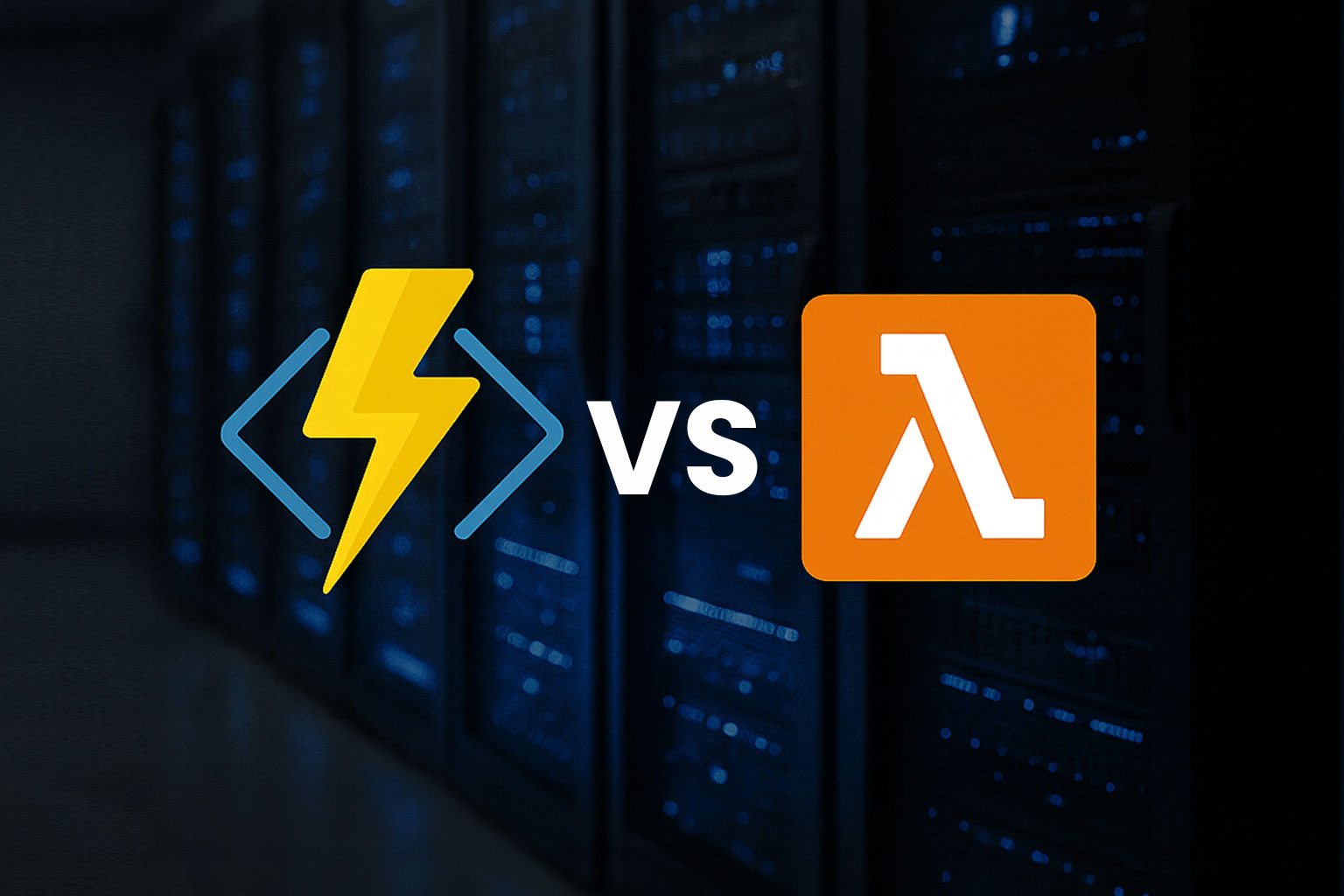Azure Functions vs AWS Lambda in 2025: Which Serverless Platform Is Best for Your Business?

30 Sep 2025
Serverless computing is a foundation of new cloud strategies. Businesses no longer need to worry about provisioning servers or scaling infrastructure, but they focus more on creating applications that respond to events and only pay for what they utilize.
When it comes to serverless platforms, Azure Functions vs AWS Lambda has been the leading debate for years. However, as more startups and companies engage in event-oriented cloud architectures in 2025, the argument over which serverless platform is best for businesses has only increased.
In this blog, we’ll provide a serverless computing comparison between Azure Functions and AWS Lambda, explore their latest features, pricing, performance, and scalability, and help you decide which is the right fit for your business.
What Is Serverless Computing?
Serverless isn’t “server-less.” Servers are still present, yet provisioning, scaling, and maintenance are automatically managed by the cloud provider. You only pay when your code runs.
Benefits include:
- Savings on costs: No idle infrastructural costs.
- Scalability: Auto scaling on demand.
- More rapid development: Concentrate on code, not infrastructure.
- Event-driven flexibility: Run functions triggered by events like API calls, database updates, or IoT signals.
This space is dominated by two platforms, Microsoft Azure Functions and AWS Lambda.
Azure Functions in 2025
Azure Functions 2025 has come a long way. It is closely connected with the enterprise ecosystem of Microsoft and is a great option to use in the case of the company already invested in either Azure or Microsoft 365.
Key Features of Azure Functions (2025)
- Supported Programming languages: C #, Java, JavaScript, Python, PowerShell, and Go.
- Event Triggers: Azure (e.g., Blob storage, Event Grid, Cosmos DB) supports hundreds of event sources.
- Deployment Models: Consumption plan (pay-per-use), Premium plan, and dedicated plan (App Service).
- Enterprise Integration: Intensive connections with Active Directory, Dynamics 365, and Azure Logic apps.
- Durable Functions: Native orchestration, stateful serverless applications, workflow.
AWS Lambda in 2025
AWS Lambda 2025 continues to lead the market in the area of serverless adoption due to its first-mover advantage and its strong connections with the rest of the AWS ecosystem. It supports millions of event-driven applications, from IoT to enterprise applications.
Key Features of AWS Lambda (2025)
- Supported Programming Languages: Node.js, Python, Java, Go, Ruby, .NET, and custom runtimes.
- Event Triggers: Intensive connectivity with AWS products such as S3, DynamoDB, Kinesis, and API Gateway.
- Deployment Models: Pay-per-request model with free tier options.
- Scalability: Up to millions of concurrent executions.
- New in 2025: AI/ML event triggers will be more enhanced, and support AI-driven workflows with AWS Bedrock.
Azure Functions vs AWS Lambda: Key Differences
Let’s break down the serverless platform choice for developers and businesses in 2025:
| Feature | Azure Functions 2025 | AWS Lambda 2025 |
| Ecosystem Fit |
Best for Microsoft-centric enterprises |
Best for AWS-native businesses |
| Language Support |
C#, Python, Java, JavaScript, PowerShell, Go |
Node.js, Python, Java, .NET, Go, Ruby, custom runtimes |
| Scalability | Strong, with Durable Functions for orchestration |
Industry-leading, supports millions of concurrent runs |
| Performance | Lower cold start times in the Premium Plan |
Optimized for ultra-low latency workloads |
| Pricing | Per-execution + compute time, Premium reduces cold starts |
Per-request + compute time, free tier available |
| Integration | Azure ecosystem, Microsoft 365, Logic Apps |
Deep AWS service ecosystem, AI/ML services |
| Best For | Enterprises using the Microsoft stack |
Cloud-native startups, AI/IoT-heavy workloads |
Performance & Scalability: 2025 Insights
- Azure Functions Performance vs AWS Lambda:
Azure has improved cold start performance with Premium Plans, making it competitive with Lambda. Ultra-low latency workloads such as IoT and high-frequency trading continue to be dominated by AWS. - Scalability:
AWS Lambda can be scaled to millions of requests with ease, whereas Azure Functions has more orchestration options available out of the box. Azure has the advantage over AWS in cases that require workflow management, and AWS has the advantage in cases of scalability.
Pricing: Azure Functions vs AWS Lambda 2025
The two platforms are based on pay-per-use systems, yet the details count:
- Azure Functions Pricing:
- $0.20 per million executions (first 1M free).
- Additional charges for memory and Premium Plans to reduce cold starts.
- $0.20 per million executions (first 1M free).
- AWS Lambda Pricing:
- $0.20 per million requests (first 1M free).
- Billed in 1ms increments for execution time.
- More granular billing makes AWS cost-effective for high-frequency, short-duration functions.
- $0.20 per million requests (first 1M free).
Takeaway: AWS Lambda can save more when the workload of the startup is unpredictable. Azure Functions Premium Plan is appealing to businesses that require reliability and enterprise-class SLAs.
Which Is Better: Azure Functions or AWS Lambda?
The answer depends on your business:
- For Startups:
AWS Lambda is often the better fit. It is cost-effective, scales immediately, and fits into the broad AWS toolset. Lambda is a popular choice when you are developing cloud-native applications.
- For Enterprises:
Azure Functions shines. It is designed to suit complex business environments with its tight integration within the Microsoft products, enterprise security, and workflow orchestration.
- For Developers:
They are both flexible, and the choice can be based on the ease with which your team integrates into the ecosystem.
Future of Serverless Platforms in 2025
The competition of Azure Functions and AWS Lambda is an expression of a larger trend: serverless is no longer a developer convenience, but a business growth accelerator.
- AI-driven workflows, IoT, and real-time analytics are being driven using event-driven architectures.
- Hybrid & multi-cloud adoption, this implies that companies can use Azure Functions and AWS Lambda interchangeably based on workload.
- The advantages of serverless architecture (cost reduction, scalability, and agility) are now the standard of modern application development.
Conclusion
The decision is not merely technical when it comes to whether to use Azure Functions 2025 or AWS Lambda 2025: It is strategic.
- Use AWS Lambda when you require raw scalability, cost-effectiveness when executing small tasks, or are already deployed in the AWS environment.
- Select Azure Functions: Use this option in case you are an enterprise that uses Microsoft products and requires highly complex orchestration, or just want to be fully integrated with Azure services.
In any case, with the best serverless platform in 2025, you can innovate more quickly, spend less time worrying about infrastructure, and focus on what is really important: growing your business.



.jpg)

